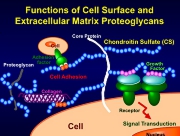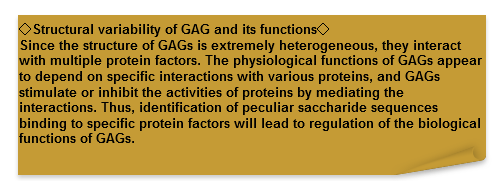Research Projects

We investigate the structure, functions and biosynthesis of glycosaminoglycans (GAGs), sulfated polysaccharides with high biological activities. Although sulfated GAGs are abundant in the animal kingdom, their presence in the vegetable world has never been reported. GAGs play important roles in cell proliferation, differentiation, cell-cell adhesion, and anticoagulation. In our laboratory, the physiological roles of these sulfated polysaccharides as well as the relationship between these sulfated polysaccharides and various diseases are investigated. The following projects are currently in progress.

If you are interested in saccharides, proteoglycan, and glycosaminoglycan, you can connect to the following web sites to get more information about them.
Glycoword-Proteoglycan
http://www.glycoforum.gr.jp/science/word/proteoglycan/PG_J.html
Hyaluronan Today
http://www.glycoforum.gr.jp/science/hyaluronan/hyaluronanJ.html
GlycoPOD (GlycoScience Protocol Online Database)
http://jcggdb.jp/GlycoPOD/protocolListShow.action


















